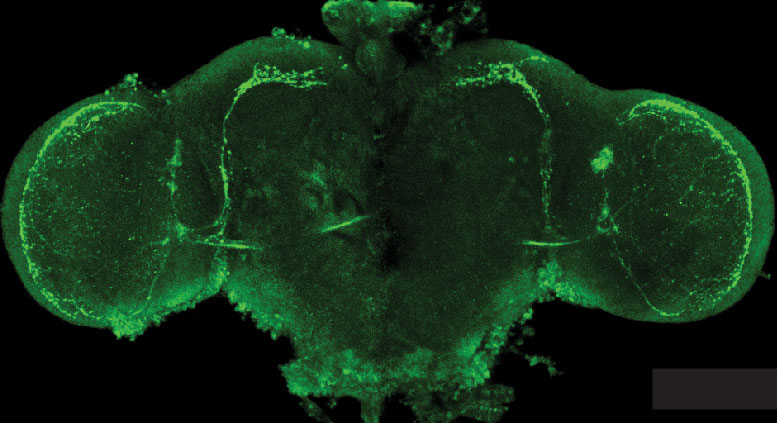Scientists watch live brain-cell circuits fire
August 14, 2013

Scientists used a new protein called ArcLight to watch electrical activity of neurons in a fly brain (credit: Nitabach Lab, Yale School of Medicine)
A new class of genetically engineered proteins called ArcLight can be used to watch electrical activity in individual brain cells in live brains, Yale University scientists have demonstrated.
These proteins may be a promising new tool for mapping brain-cell activity and for studying how neurological disorders disrupt normal neuron signaling. Understanding brain cell activity is a high priority of the Brain Research through Advancing Innovative Neurotechnologies (BRAIN) Initiative.
ArcLight proteins fluoresce (glow) as a neuron’s voltage changes, enabling researchers to watch, in real time, the cell’s electrical activity. In this study, the scientists engineered fruit flies to express ArcLight in brain cells that control the fly’s sleeping cycle or sense of smell.
This study, led by Michael Nitabach, Ph.D., J.D., and Vincent Pieribone, Ph.D.,at the Yale School of Medicine, shows that a class of proteins called genetically encoded fluorescent voltage indicators (GEVIs) may allow researchers to watch nerve cell firing in a live animal.
The experiments showed that ArcLight illuminated firing in parts of the brain that were previously inaccessible using other techniques. ArcLight also allowed the researchers to watch brain cells fire while the flies were awakening and smelling. These results suggest that in the future neuroscientists may be able to use ArcLight and similar genetically engineered proteins in a variety of ways to map brain cell circuit activity during normal and disease states.
This study was supported by grants from NINDS and NIGMS/
GEVIs and other sensors are being developed by a group of NINDS-funded researchers who are part of the Fluorogenetic Voltage Sensors Consortium. The consortium was partly funded with grants from the American Recovery and Reinvestment Act.
Above shows ArcLight fluorescence change over time in one cell. The researchers focused on two spots: in the middle of the cell body (red) and on the edge of the cell body (green). The flashing colors represent changes in voltages. Below are three traces. The red and green traces summarize the change fluorescence seen over time whereas the white trace represents the cell voltage which was simultaneously recorded with an electrode. The figure shows that changes in ArcLight fluorescence appear to accurately track changes in nerve cell voltage.
In this video, the researchers watched changes in fluorescence from five spots: two nerve cell bodies (blue and brown circles — lower left-hand corner) and three neurites or processes (red, yellow, and green circles). The traces summarize the changes in fluorescence over time. The experiments were performed in flies that express a bacterial sodium channel which induces large spontaneous depolarizing changes in voltage. The video shows that ArcLight allowed researchers to watch voltage changes at different times from multiple locations and in multiple cells.